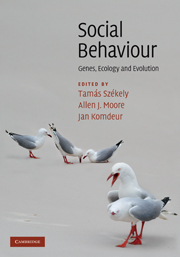Book contents
- Frontmatter
- Contents
- List of contributors
- Introduction: The uphill climb of sociobiology: towards a new synthesis
- Profile: Undiminished passion
- Part I Foundations
- Part II Themes
- 7 Aggression: towards an integration of gene, brain and behaviour
- Profile: From behavioural observations, to genes, to evolution
- 8 Social influences on communication signals: from honesty to exploitation
- Profile: Reputation can make the world go round – or why we are sometimes social
- 9 Important topics in group living
- Profile: A haphazard career
- 10 Sexual behaviour: conflict, cooperation and coevolution
- Profile: In celebration of questions, past, present and future
- 11 Pair bonds and parental behaviour
- Profile: Mating systems and genetic variation
- 12 Adaptations and constraints in the evolution of delayed dispersal: implications for cooperation
- Profile: Selections from a life in social selection
- 13 Social behaviour in microorganisms
- Profile: The de novo evolution of cooperation: an unlikely event
- 14 Social environments, social tactics and their fitness consequences in complex mammalian societies
- Profile: Evolutionary genetics and social behaviour: changed perspectives on sexual coevolution
- 15 Social behaviour in humans
- Profile: Genes and social behaviour: from gene to genome to 1000 genomes
- Part III Implications
- Species index
- Subject index
- References
Profile: From behavioural observations, to genes, to evolution
Published online by Cambridge University Press: 05 June 2012
- Frontmatter
- Contents
- List of contributors
- Introduction: The uphill climb of sociobiology: towards a new synthesis
- Profile: Undiminished passion
- Part I Foundations
- Part II Themes
- 7 Aggression: towards an integration of gene, brain and behaviour
- Profile: From behavioural observations, to genes, to evolution
- 8 Social influences on communication signals: from honesty to exploitation
- Profile: Reputation can make the world go round – or why we are sometimes social
- 9 Important topics in group living
- Profile: A haphazard career
- 10 Sexual behaviour: conflict, cooperation and coevolution
- Profile: In celebration of questions, past, present and future
- 11 Pair bonds and parental behaviour
- Profile: Mating systems and genetic variation
- 12 Adaptations and constraints in the evolution of delayed dispersal: implications for cooperation
- Profile: Selections from a life in social selection
- 13 Social behaviour in microorganisms
- Profile: The de novo evolution of cooperation: an unlikely event
- 14 Social environments, social tactics and their fitness consequences in complex mammalian societies
- Profile: Evolutionary genetics and social behaviour: changed perspectives on sexual coevolution
- 15 Social behaviour in humans
- Profile: Genes and social behaviour: from gene to genome to 1000 genomes
- Part III Implications
- Species index
- Subject index
- References
Summary
My interest in social behaviour probably stems from me belonging to a species where social interactions rule our lives. As a teenager I was very interested in psychiatry, and I also recall spending hours observing the human-like attitudes of chimpanzees and gorillas in the zoo. Accordingly, while studying biology at university, I seriously considered the option of studying chimpanzees. But at the time of graduating I had come to realise that this was not an easy task. Either one would conduct studies in the field with the only hope to collect sparse observational data, or one could study chimpanzees in enclosures, but the very contrived and artificial environment makes it difficult to understand how behaviour might have been modulated by natural selection. I therefore started to think about other social organisms that could be easily observed and, importantly, where it was possible to experimentally manipulate key components of social organisation. This paved the way for my interest in myrmecology.
My first work in the field of myrmecology (the ant world) was primarily concerned with understanding the evolution of multiple-queen colonies, which at that time was seen as a major problem for kin selection theory. During my PhD and postdoc I conducted many experiments, which, together with the work of some colleagues, allowed us to solve the apparent paradox of reduced relatedness stemming from colonies containing several reproductive queens.
- Type
- Chapter
- Information
- Social BehaviourGenes, Ecology and Evolution, pp. 181 - 184Publisher: Cambridge University PressPrint publication year: 2010



